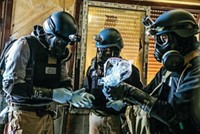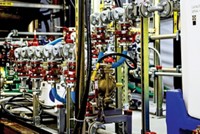Advertisement
Grab your lab coat. Let's get started
Welcome!
Welcome!
Create an account below to get 6 C&EN articles per month, receive newsletters and more - all free.
It seems this is your first time logging in online. Please enter the following information to continue.
As an ACS member you automatically get access to this site. All we need is few more details to create your reading experience.
Not you? Sign in with a different account.
Not you? Sign in with a different account.
ERROR 1
ERROR 1
ERROR 2
ERROR 2
ERROR 2
ERROR 2
ERROR 2
Password and Confirm password must match.
If you have an ACS member number, please enter it here so we can link this account to your membership. (optional)
ERROR 2
ACS values your privacy. By submitting your information, you are gaining access to C&EN and subscribing to our weekly newsletter. We use the information you provide to make your reading experience better, and we will never sell your data to third party members.
Energy
Mission To Destroy Syria’s Chemical Weapons Moves Slowly
U.S. cargo ship that will destroy Syria’s most dangerous chemical weapons must wait in Spain until Syria completes the turnover of its stockpile
by Glenn Hess
February 13, 2014
| A version of this story appeared in
Volume 92, Issue 7

Facing wide criticism over the slow progress in the international effort to destroy Syria’s chemical warfare arsenal, the Syrian government says that its most dangerous chemical weapons will be removed from the country by Feb. 28. And it insists that it will meet the final June 30 deadline for the total elimination of its chemical weapons program.
Syria has missed two deadlines in a United Nations-sanctioned timetable for the destruction of its chemical arms. Under the accord, Syria was supposed to remove its most poisonous chemical agents by Dec. 31 and give up its entire stockpile by Feb. 5. The Syrian government has ascribed the delays to security concerns related to the civil war. So far, only a small portion of Syria’s 1,300-metric-ton stockpile has been transported from 12 storage sites around the country to the Port of Latakia.
“The international community is poised and ready to destroy Syria’s chemical weapons,” Pentagon spokeswoman Jennifer Elzea says. “It is [President Bashar] Assad regime’s responsibility to transport the chemicals to Latakia safely for removal. We expect them to meet their obligation to do so.”
From Latakia, the material is being loaded onto Norwegian and Danish vessels for eventual transfer to the MV Cape Ray, a U.S. cargo ship on a mission to destroy Syria’s most dangerous chemical weapons at the port of Gioia Tauro in Calabria, Italy.
The Cape Ray departed Norfolk Naval Station in Virginia on Jan. 27 for the region. It will remain at a naval base in Rota, Spain, until the Syrian regime turns over the rest of its stockpile, Defense Department officials said on Monday.
At Gioia Tauro, the Cape Ray will take possession of the Syrian sulfur mustard agent and nerve agent precursor chemicals from the Scandinavian ships and head out to international waters in the Mediterranean Sea.
Chemists, engineers and other specialists from the U.S. Army will use two mobile hydrolysis units on board the Cape Ray to neutralize the chemical weapons (C&EN, Feb. 10, page 24).
Only 11% of Syria’s chemical weapons stockpile has been shipped to Italy, according to The Hague-based Organisation for the Prohibition of Chemical Weapons, which is overseeing the operation.
Once all the chemical materials are onboard the Cape Ray, neutralization operations will take between 45 and 90 days, the Pentagon says.




Join the conversation
Contact the reporter
Submit a Letter to the Editor for publication
Engage with us on Twitter